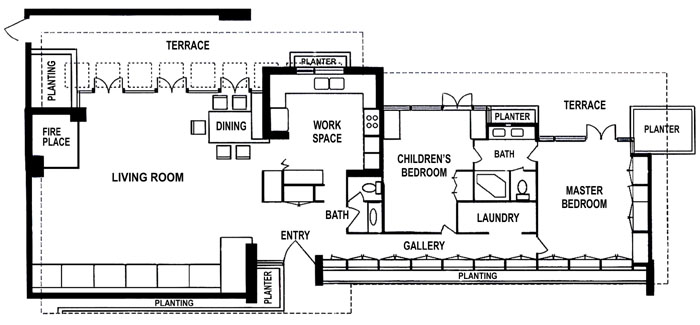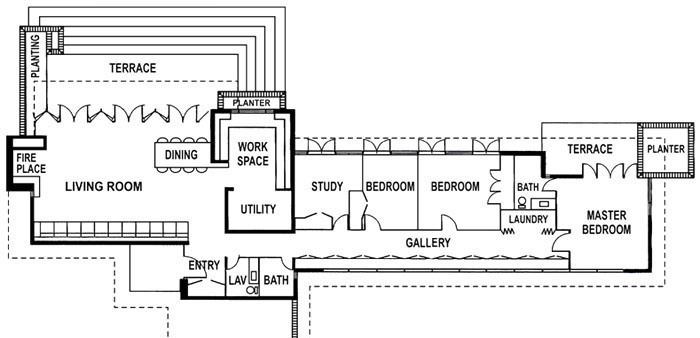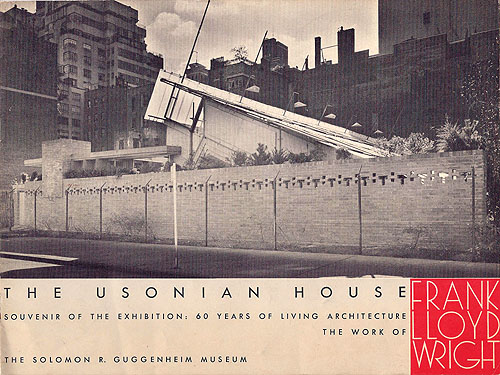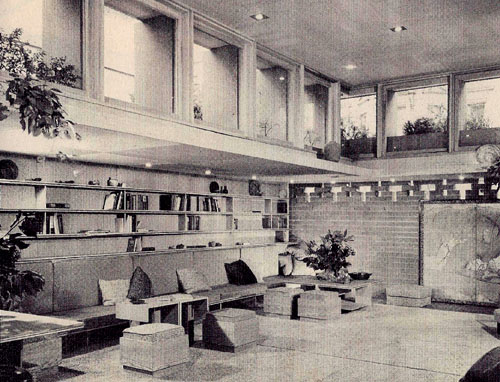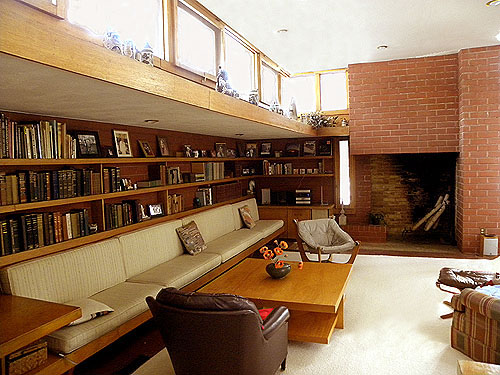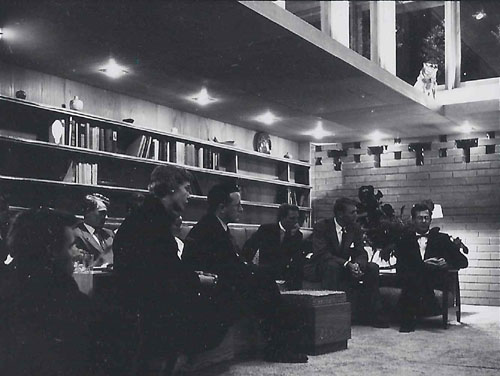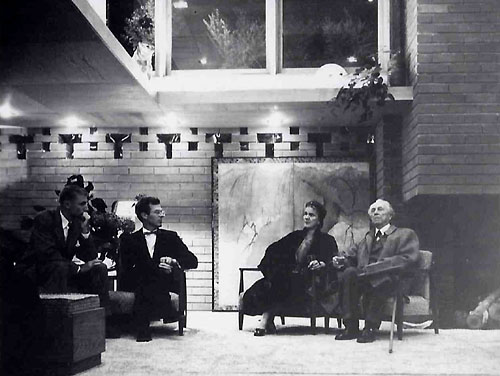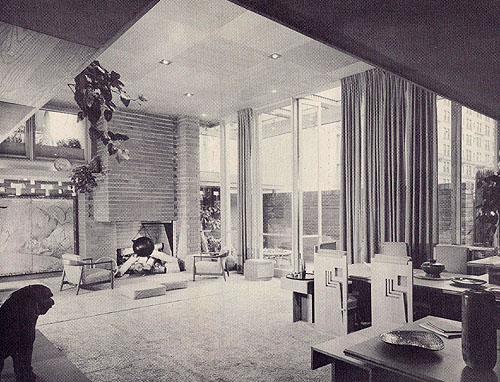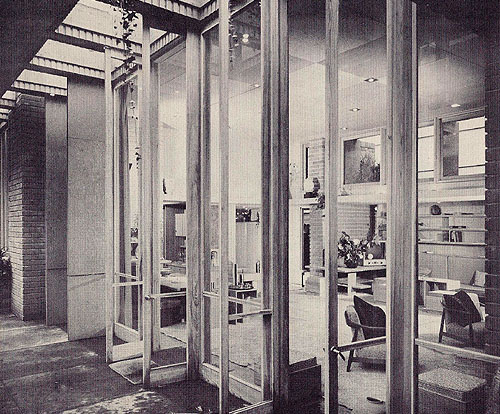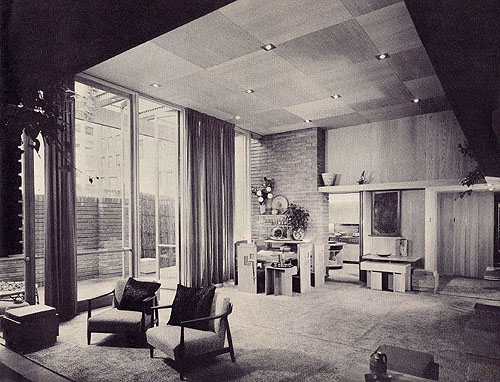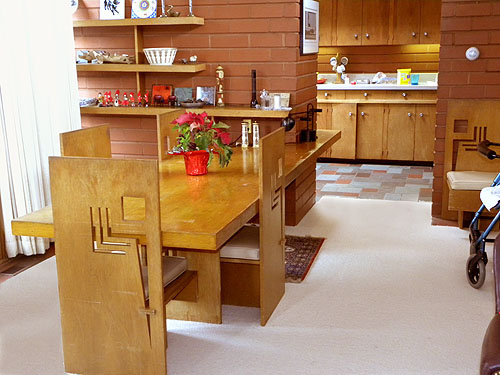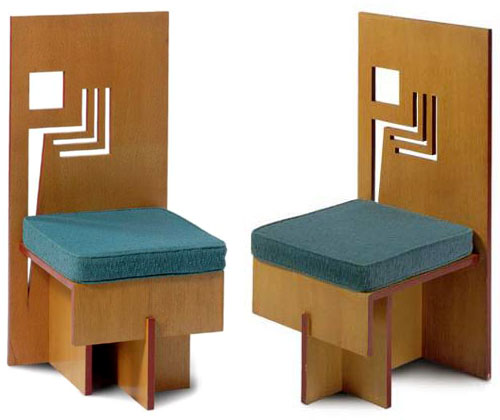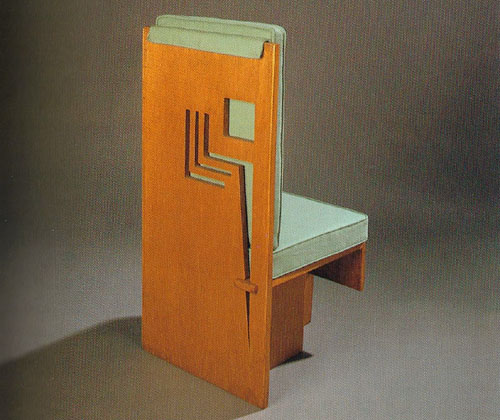Paul and Ida Trier Residence, Johnston, Iowa (1956) (S.398)
The 1953 New York Usonian Exhibition House (S.369) and The 1956 Trier Residence
The Trier Residence is based on the Usonian Exhibition House (S.369) that was built in 1953 on the site for The Guggenheim Museum. The Trier Residence was the second home to utilize this floor plan. The first being the Feiman Residence (S.371). Wright's initial drawing of the home shows that he conceived the Trier Residence as a Usoniam Automatic, constructed of 12 x 24" concrete blocks. The working drawings specify the home to be constructed of brick. The Triers elected to use brick, and then substituted brick tile, to save construction costs. The 4 x 12" size remained consistent with Wright's original dimensions. The Trier's original floor plan created approximately 1740 square feet of living space, not including the Work Shop. The Living Room occupied thirty percent of the living space.
The complex on the grounds that would eventually become the Guggenheim Museum consisted of two structures. The New York Usonian Exhibition House (S.369) and the Pavilion (S.370), both seen on the cover of the catalog below. "Sixty Years of Living Architecture: The Work of Frank Lloyd Wright", was a traveling exhibition of Wright's work, consisting of Models, photographs and original drawings. A Preview of the exhibition was held in Philadelphia (January 1951). The world wide tour opened in Palazzo Strozzi Florence, Italy (June 1951). In "Sixty Years" (New York), Wright notes that from Florence the Exhibition traveled to "Switzerland, France, German and Holland". The Exhibition catalogs are dated: Paris (April 1952), Zurich (End of May 1952), Munich (May 16 - June 15, 1952), and Rotterdam (dated June 1, 1952). After two years in Europe the exhibition crossed theAtlantic to Mexico City, then to New York (1953). After an exhibition in Los Angeles (1954) Wright indicates (LA) that the Exhibition was headed to the Orient. Manila, Tokyo and New Delhi in 1955. Note: We found no evidence that the Orient exhibitions took place. In "FLW, His Life, His Work, His Words" pp. 219-220, Mrs. Wright indicates that after the Exhibition in LA, "...it returned to Taliesin". Also of interest is the booklet that was published for the Exhibition held in Chicago. Included in the title of the booklet is "Series Nine Chicago". When you count the number of exhibitions, eliminating the Orient, Chicago is number nine. 1) Florence 2) Switzerland 3) France 4) German 5) Holland 6) Mexico City 7) New York 8) Los Angeles 9) Chicago. The exhibition catalog is dated October 16, 17, 18, 1956. Mayor Daley proclaimed October 17, Frank Lloyd Wright Day.
The New York House and Pavilion were constructed at the same time. The exhibition was held from October 22 - November 29, 1953. Two booklets were produced. One for the House (below) and one for the Exhibition. The exhibition included a fully furnished 1,700 sq. ft. ''Usonian House''. Wright used the same design for the dining chair in other homes including Trier Residence. On occasion, furniture from the exhibition are offered at auction houses.
After the exhibition in New York, the house was auctioned off. The buyer contracted polio and was unable to reconstruct the home. In 1984, after sitting in storage for 30 years, it was put up for auction again. Tom Monaghan won the bid at $117,000. Plans were made to reconstruct the home, but time had taken its toll. Parts were eventually auctioned off again in 1992.
The Usonian Exhibition House floor plan created approximately 1,700 square feet of living space.
The Trier's original floor plan created approximately 1,740 square feet of living space, not including the Work Shop. The Living Room occupied thirty percent of the living space. The Trier Residence Living Room was reduced, and the Bedroom Wing enlarged, allowing the addition of a Study. (See full Floor Plan.)
NY 1: The complex on the grounds that would eventually become the Guggenheim Museum consisted of two structures. The New York Usonian Exhibition House (left, S.369) and the Pavilion (right S.370). The New York House and Pavilion were constructed at the same time. The exhibition was held from October 22 - November 29, 1953. Two booklets were produced. This one for the House (above) and one for the Exhibition. (Published by The Solomon R. Guggenheim Museum, New York.) 2: Classic Usonian elements were prominent in the New York Usonian Exhibition House. Built-in seating and shelving. Clerestory windows allowed natural lighting into the Living Room. The Living Room ceiling height was approximately 7 feet on the left and opens up to 12 feet on the right. (Photographed by Ezra Stoller.) 3: The Trier Residence followed the same floor plan as the Exhibition House, with minor changes. The Living Room ceiling height was reduced from 12 feet to 10 feet 9 inches on the right. While the Fireplace design was very similar, it was moved to the left, and the opening was much higher. The Trier Residence Living Room was reduced, and the Bedroom Wing enlarged, allowing the addition of a Study. 4: New York Usonian Exhibition House and Pavilion opening reception, October 22,1953. See additional photographs. (Photographed by Pedro Guerrero.) 4B: New York Usonian Exhibition House and Pavilion opening reception, October 22,1953. See additional photographs. (Photographed by Pedro Guerrero.) 5: The Living Room's wall of floor to ceiling doors and windows open outward, blending interior with exterior. The Dining area is on the right. (Photographed by Ezra Stoller.)
6: Viewed from the Terrace into the Dining area and Living Room. Sets of 12 foot doors open outward and extend to the full height of the Living Room. The cantilevered roof overhang is richly patterned with ornamental dentil bands. (Photographed by Ezra Stoller.) 7: Not only do the three sets of double floor to ceiling doors open outward but the decorative light screen pilaster windows do as well. Glass intersects and is imbedded into the brick-tile wall. 8: Fireplace is is on the far left, Terrace, Dining area and Work Space in the center, and Entry to the far right. The brick is a deep red, and is complimented by a patterned ceiling of red oak plywood. The Dining table and chairs were designed and built specifically for this exhibition house. (Photographed by Ezra Stoller.)
9: The Trier's Dining area includes built-in shelving and dining room table. Ida reminisced about the furniture. "Paul built all the furniture. Wright designed the Dining Room table 3-4 inches shorter than the standard dining room table to make the ceiling look taller". Work Space can be seen in the background through the opening. The Entryway is to the right. 10: Usonian Exhibition Dining Chair, 1953. Designed by Frank Lloyd Wright for the Usonian Exhibition House exhibited in "Sixty Years of Living Architecture: The Work of Frank Lloyd Wright", at The Solomon R. Guggenheim Museum exhibition grounds, New York, 22 October - 29 November 1953. For the retrospective of Frank Lloyd Wright's work in 1953, Wright built a fully furnished ''Usonian House'' and pavilion in the museum gardens. The house was described in a New York Times article as a ''fusion of architecture and furnishings, the blending of indoors and out.'' These two chairs were designed and built specifically for the exhibition house. Wright later used the same model for the Trier Residence, Iowa, 1956. Oak plywood, 37 inches high. Manufactured by Plycraft Products. (Sotheby's description. Sale date December 2003. Sold for $24,000 each plus buyer's premium.) 11: Original dining chair designed for the Paul J. Trier Residence in 1956, was sold in New York in 1986 and became part of the Domino's Pizza Collection. Published in "Frank Lloyd Wright. Preserving an Architectural Heritage", Hanks, 1989, page 112-113. Courtesy Domino's Pizza Collection. (Photographed by Gregg Campbell.)
Text and Photographs by Douglas M. Steiner, unless otherwise noted, Copyright 2010 BACK
